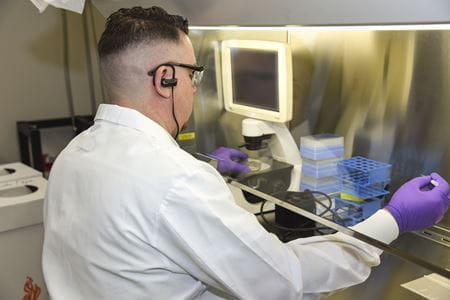Eleven departments ranked in top 25 among all U.S. medical schools
INDIANAPOLIS—Indiana University School of Medicine researchers received over $214.8 million in total funding from the National Institutes of Health during federal fiscal year 2022, making the school the No. 14 NIH-funded public medical school in the country.
According to the Blue Ridge Institute for Medical Research, 11 IU School of Medicine departments ranked in the top 25 nationally for 2022 NIH funding among all U.S. medical schools, including five departments ranked in the top 15:
- The Department of Medical and Molecular Genetics is ranked No. 6 in 2022, up from No. 8 in 2021.
- The Department of Pediatrics is ranked No. 7 in 2022, up from No. 9 in 2021.
- The Department of Biostatistics and Health Data Science is ranked No. 10 in 2022, up from No. 12 in 2021.*
- The Department of Obstetrics and Gynecology is ranked No. 11 in 2022, up from No. 21 in 2021.
- The Department of Anatomy, Cell Biology and Physiology is ranked No. 14 in 2022, up from No. 18 in 2021.
Other IU School of Medicine departments ranked in the top 25 nationally include the Department of Otolaryngology-Head and Neck Surgery (17), the Department of Emergency Medicine (19), the Department of Urology (21), the Department of Radiology and Imaging Sciences (23), the Department of Physical Medicine and Rehabilitation (24), and the Department of Biochemistry and Molecular Biology (25).
“As the largest medical school in the U.S., we are proud to be a leading institution when it comes to NIH-funded research in many areas of medicine, making IU School of Medicine a top destination for research across disciplines,” IU School of Medicine Dean Jay L. Hess, MD, PhD, MHSA, said. “NIH grants are the most prestigious funding researchers can receive. This funding demonstrates balanced excellence in research within the school as our physicians and scientists across all specialties continue to better understand and treat some of the most difficult and complicated health challenges.”
Based on the figures in a report by United for Medical Research, in 2021, every $1 million in NIH funding awarded to Indiana researchers created about 12 jobs, the income and other associated expenses from which generated $2.74 million in economic activity in the state. Based on that data, IU School of Medicine’s 2022 NIH funding is responsible for creating 2,032 jobs and an estimated $589 million in annual economic activity in Indiana – more than half of the total $1.01 billion in economic activity generated in Indiana from all NIH funding in the state.
“IU School of Medicine faculty continue to lead innovative and high-impact research that is tackling areas of priority to the National Institutes of Health,” said Tatiana Foroud, PhD, executive associate dean for research affairs and August M. Watanabe Professor of Medical Research at the school. “I am proud of the leadership our school demonstrates in driving medical research, discovery and innovation in the state and nation. I look forward to seeing the research of our faculty, staff and students improve health in Indiana and beyond.”
This year, IU School of Medicine used Blue Ridge Institute for Medical Research rankings instead of internally calculating rankings based on NIH funding data. An independent, nonprofit organization, Blue Ridge has published rankings of medical schools, departments and investigators since 2006 and is widely considered the industry standard for U.S. medical school rankings. Data are compiled and released annually shortly after the federal fiscal year ends.
See a top 10 list of IU School of Medicine’s largest NIH grants in 2022 on the school’s blogs hub.
*This ranking isn’t displayed directly on the Blue Ridge Institute for Medical Research website. However, it was calculated by IU School of Medicine using Blue Ridge source data.
About IU School of Medicine
IU School of Medicine is the largest medical school in the U.S. and is annually ranked among the top medical schools in the nation by U.S. News & World Report. The school offers high-quality medical education, access to leading medical research and rich campus life in nine Indiana cities, including rural and urban locations consistently recognized for livability.




